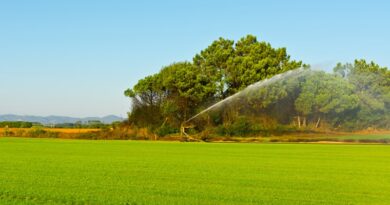Small-scale farmers hit hard by climate change, see poor finance inflows

Small-scale farmers in developing countries are disproportionately experiencing the effects of climate change variability, largely through droughts and floods, but are only receiving just 1.7 per cent of the global climate finance inflows, a new report has warned.
Only a fraction of what is needed goes to small-scale farmers in developing countries despite their disproportionate vulnerability to the impacts of climate change, the report released by the UN’s International Fund for Agricultural Development (IFAD) and Climate Policy Initiative (CPI) said, adding that these farmers are also at risk of external shocks such as the COVID-19 pandemic.
The report, ‘Examining the Climate Finance Gap for Small-Scale Agriculture’, is the first detailed analysis of climate finance flows to small-scale farmers. It was released recently during the Finance in Common Summit where representatives of the world’s 450 public development banks met for the first time to discuss how to reorient financial flows to support global climate and development targets.
According to the report, while financing that supports actions to address climate change surpassed $0.5 trillion for the first time in 2017-2018, only $10 billion of this reached smallholder farmers annually.
Small-scale farmers in developing countries are disproportionately experiencing the effects of climate change variability, largely through droughts and floods, but are only receiving just 1.7 per cent of the global climate finance inflows, a new report has warned.
Only a fraction of what is needed goes to small-scale farmers in developing countries despite their disproportionate vulnerability to the impacts of climate change, the report released by the UN’s International Fund for Agricultural Development (IFAD) and Climate Policy Initiative (CPI) said, adding that these farmers are also at risk of external shocks such as the COVID-19 pandemic.
Out of the total tracked climate finance of $20 billion for agriculture, forestry, and land use, only $8.1 billion targets small-scale farmers, agri-entrepreneurs and value chain actors serving them.
This is equivalent to approximately 40 per cent of the total climate funds committed to the agriculture, forestry, and land use sectors. An additional $1.72 billion of climate finance benefits small-scale agriculture actors through renewable energy generation, sustainable transport in rural areas and water management.
Sub-Saharan Africa, East Asia and Pacific, and South Asia were the largest recipients of climate finance for small-scale producers in 2017-2018. This is aligned with the prevalence of small-scale producers in these regions. In Sub-Saharan Africa, for example, small-scale farmers constitute 60 per cent of the population.
“It is unacceptable that the people who produce much of the world’s food, and who are at the greatest mercy of increasingly unpredictable weather, receive the least support,” said IFAD President Gilbert F Houngbo.
“Small-scale farmers living on marginal lands are on the frontline of climate change and should have access to the climate finance they need to adapt their production.”
Small-scale farmers currently produce 50 per cent of the world’s food calories. However, higher temperatures – together with increased incidences of drought and flooding – destroy crops and livestock and make it difficult for them to continue to feed their communities and earn a living.
Small-scale farmers operating on less than 5 hectares of land represent around 95 per cent of world’s farms and a cumulated area equivalent to 20 per cent of the global farmland. In Asia and Sub-Saharan Africa, small-scale farmers are estimated to provide up to 80 per cent of the food produced. Most of the world’s small-scale farmers live in these regions, where the agricultural sector contributes around 15 per cent of the GDP and provides over 40 per cent of all the jobs.
“Our findings show that only a small percentage of the money invested in climate action globally makes its way to smallholder farmers. This lack of financing could have dire effects, as smallholder farmers urgently need more support to sustain their livelihoods in the face of climate change,” said CPI’s Global Managing Director Dr Barbara Buchner.
While there are no exact figures available of what climate financing small-scale farmers require, various estimates of their general needs are in the order of hundreds of billions annually, which gives an indication of the magnitude of the climate investments required.
“Governments must make sure that climate finance gets to the people who need it most, and smallholder farmers should be top of that list, not at the bottom,” said IFAD’s Environment, Climate and Social Inclusion Director Margarita Astralaga.
Governmental donors, multilateral and bilateral development banks, and climate funds should work together to further enhance their reporting of climate finance for small-scale agriculture under a common definition and set methodology. Also, public donors and funders should initiate a similar dialogue with private sector actors, including foundations, private finance institutions, and corporate entities. Reporting mechanisms should be designed with the needs and priorities of private sector entities in mind, in order to enable future consistent reporting across both private and public sectors, the report added.
“IFAD aims to support this by increasing public and private climate finance flows to small-scale farmers.”
The report recommends that collaboration between the public and private sectors should be enhanced to mitigate the risk associated with investments in the agricultural sector and leverage additional financial resources. “Weather indexed insurance has the potential to de-risk loan products, thus private and public funders should invest in development of low-cost insurance products using technology to decrease complexity and costs”.
Also, governments should make more effective use of public resources and policies targeting risk management and capacity building for climate-related finance and incentivizing conservation efforts at local level. “Subsidized loans to small-scale producers and agri-businesses should be made conditional on the implementation of climate-smart agricultural practices and technologies and should be coupled with technical assistance adapted to each specific agro-ecological zone”.
International and domestic climate flows should stimulate the transition of agri-businesses and finance service providers towards low emission supply chains.



